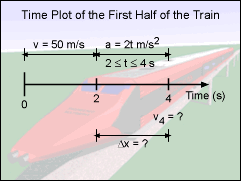| Ch 1. Particle General Motion | Multimedia Engineering Dynamics | ||||||
|
Position, Vel & Accel. |
Accel. vary w/ Time |
Accel. Constant | Rect. Coordinates | Norm/Tang. Coordinates | Polar Coordinates |
Relative Motion |
|
| Line Motion: Acceleration with time | Case Intro | Theory | Case Solution | Example |
| Chapter |
| - Particle - |
| 1. General Motion |
| 2. Force & Accel. |
| 3. Energy |
| 4. Momentum |
| - Rigid Body - |
| 5. General Motion |
| 6. Force & Accel. |
| 7. Energy |
| 8. Momentum |
| 9. 3-D Motion |
| 10. Vibrations |
| Appendix |
| Basic Math |
| Units |
| Basic Dynamics Eqs |
| Sections |
| eBooks |
| Dynamics |
| Fluids |
| Math |
| Mechanics |
| Statics |
| Thermodynamics |
| ©Kurt Gramoll |
|
|
||
| Introduction |
||
 Train Motion |
A high-speed train is traveling at 50 m/s when the first half of the train, which includes the engine, breaks away from the second half. Due to the loss in weight and drag, the first half of the train accelerates for two seconds before the engineer regains control. What is known:
|
|
 Train conditions over time |
Question |
|
|
Knowing the acceleration of the train as a function of time after the break, what is the velocity of the first half of the train at t = 4 seconds, and how far does it travel from t = 2 to t = 4 seconds?
|
||
| Approach |
||
|
||
Practice Homework and Test problems now available in the 'Eng Dynamics' mobile app
Includes over 400 free problems with complete detailed solutions.
Available at the Google Play Store and Apple App Store.